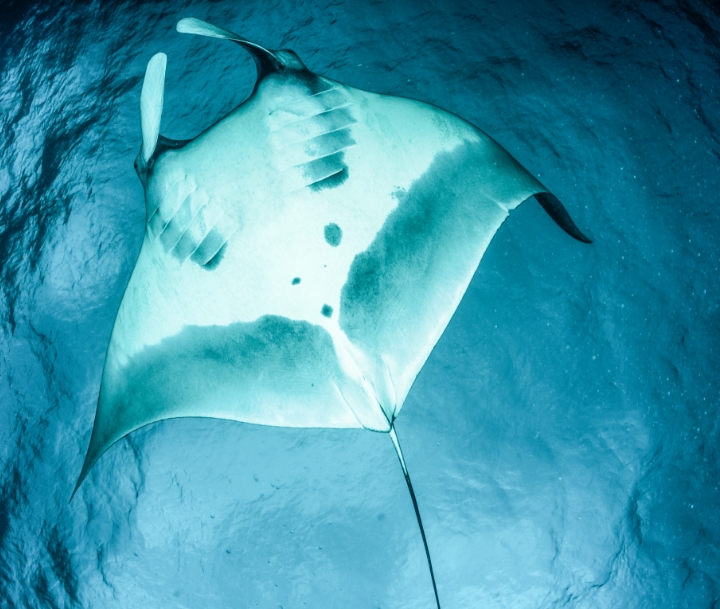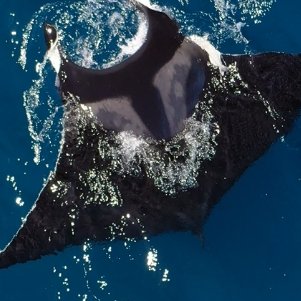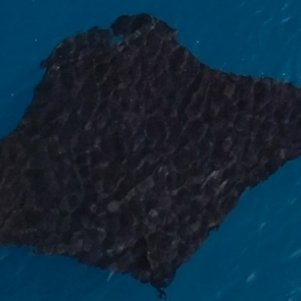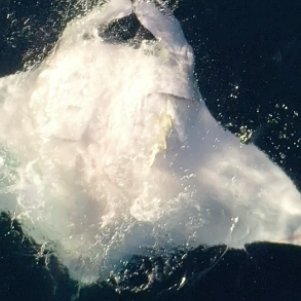Mark Erdmann, 2017

Rowan Virbickas, 2019
OCEANIC MANTA RAYS ARE THE WORLD’S LARGEST SPECIES OF RAY AND CAN REACH 7 METERS ACROSS AND WEIGH UP TO 2 TONNES
Mobula Birostris
Oceanics have a worldwide distribution, inhabiting both tropical and temperate oceans. Oceanic manta rays have extremely conservative life histories i.e. they are long lived, slow growing and reach sexual maturity in their early teens. Manta rays give birth to a single (sometimes twins), fully developed pup every 2 to 5 years, after 12.5 months gestation.
This slow and steady approach makes manta rays extremely vulnerable to any form of exploitation, as it takes populations a long time to replace and rebuild those lost.
Unfortunately, oceanic manta rays are now experiencing global population decline due to targeted and bycatch fisheries. This has resulted in this species being reclassified from Vulnerable to Endangered on the IUCN Red List.

Not only are oceanic mantas pretty hefty, research shows that they are also super brainy! Manta rays are highly inquisitive animals, in-water encounters with these majestic gentle giants can be incredibly interactive.
Manta rays have the largest brain of any fish, the size of which is comparable to similar sized mammals, which isn’t the case for other large fish (look no further than whale sharks!). They are also the only species of fish to have passed the mirror test, proposing that mantas are actually self-aware. The only other animals to pass this test are chimps, dolphins, and humans!
Without a doubt, oceanic mantas rays are one of the hardest species to study. As far as manta rays go, these guys tend to be much more elusive than their smaller, warm water cousins the reef mantas. Oceanic mantas do visit shallow reefs but are more likely to hang out in deeper water, further offshore in association with offshore islands and continental shelves.
Average: 4-5 m
Max: 7 m
Up to 2,000 kg
Likely to be
around 40 years

Edy Setyawan, 2021

Mark Erdmann, 2021
Manta rays along with many other marine species express what is known as counter-shading, whereby their colouration is darker on the dorsal or top side and lighter on the ventral or underside. This colour combination allows mantas to blend in with the background light conditions, making it harder for potential predators to attack from below.
On top, oceanic manta rays are characterised by their white shoulder markings that form a black ‘T’ shape on the top of their heads and their modified head fins or lobes. When in feeding mode, these cephalic fins open up and enable the mantas to funnel their zooplankton prey directly into their mouths. When not feeding, cephalic lobes are rolled up but appear to have additional tactile and communication functions and have even been known to change colour!
All manta rays have a unique spot pattern on their bellies, much like a human finger print.
All manta rays have a unique spot pattern on their bellies. Oceanic manta rays have their belly spots clustered around the lower abdomen below the gills.
These spot patterns are of particular interest to manta researchers and by cataloging these images, Manta Ray ID Databases can be established. These databases provide a visual record of individuals over time and are a great way to learn more about a specific population, like here in NZ.
The colouration of individual manta rays can vary significantly within and between different populations. These colour morphs can range from extremely dark (melanistic) through to very pale (leucistic), with the majority of individuals falling somewhere between the two colour extremes, with are known as chevron mantas.
In NZ we are lucky to have all three colour morphs, chevron being the most common. Melanistic or black morphs, are only present in some manta ray populations. These mantas
usually have a completely black dorsal surface and aside from looking super cool are really exciting to encounter.

Mark Erdmann, 2017

Mark Erdmann, 2021

Edy Setyawan, 2021

Edy Setyawan, 2021

Edy Setyawan, 2021

Rowan Virbickas, 2019

Blair Herbert, 2019

Troy Underwood, 2020
Finding the perfect partner is tricky at the best of times, so dating in the great expanse of the open ocean is likely to be quite a challenge. Therefore, it’s not surprising to find out that when a male oceanic manta ray finds a suitable lady friend, he doesn’t let her out of his sight! Romance quickly turns into an endurance test, as the male shadows the female for what is likely to be an extensive amount of time.
There are plenty of knowledge gaps concerning the finer details of oceanic manta ray courtship, however what we do know is that in NZ male mantas pair with a heavily pregnant female. It’s suspected that the male follows the female and mates with her once she has given birth.
The actual act is likely to last only a few seconds and goes a bit like this: on the female’s signal both manta rays swim up to the surface, and the male uses his tiny teeth to bite onto the female’s left pectoral fin. He clamps down on her fin, simultaneously swinging his body so that they momentarily are belly to belly and one of the male’s claspers do the rest. Everything must happen quickly as both mantas begin to sink and will soon need to detach to breath.